Unlock AI Potential: Storyboards, Resumes, and Mobile Apps
Artificial intelligence is transforming our daily lives and work environments at a breakneck pace. From generating breathtaking visuals to streamlining mundane tasks, AI tools have become essential for professionals in various fields. This article dives into the practical uses of AI, focusing on three main areas: crafting storyboards, enhancing resumes and cover letters, and exploring top mobile AI apps that can elevate your productivity. Whether you're a filmmaker, job seeker, or just someone looking to harness AI for everyday tasks, this guide will provide you with the insights and tools to tap into AI's potential.
Key Points
- Using ChatGPT and DALL-E to create storyboards for efficient visualization.
- Employing GPTs to craft compelling resumes and cover letters.
- Discovering the best mobile AI apps for various tasks.
- Understanding the advantages and possibilities of AI in creative and professional fields.
- Learning how to refine AI-generated content for the best outcomes.
Storyboard Creation with AI
The Power of AI in Storyboarding
Storyboarding is a vital part of filmmaking, animation, and game development, allowing creators to visualize their concepts and plan scenes before diving into production. Traditionally, this process can be time-consuming, often requiring specialized artists and extensive communication. However, AI offers a game-changing solution that can make storyboarding more efficient.
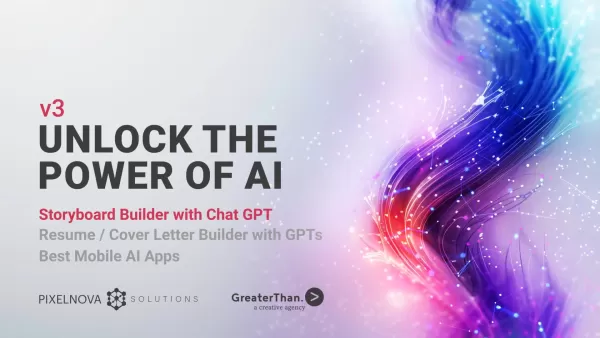
By using tools like ChatGPT and DALL-E, you can generate storyboard frames from text prompts, significantly cutting down on time and costs compared to traditional methods. This section will guide you on how to effectively use these AI tools to create engaging storyboards.
Key tools for AI-powered storyboarding include:
- ChatGPT 4 (for text prompts)
- DALL-E (for image generation)
- Adobe Illustrator (for final touches, optional)
Crafting Effective Prompts for ChatGPT
The success of AI-generated storyboards hinges on the quality of your text prompts. A well-thought-out prompt can guide ChatGPT and DALL-E to produce images that align closely with your vision.
Here's an example of a prompt for generating a scene in a storyboard:
"You need a scene of a happy male in his 40s with a beard holding a cat. He is in cat heaven! His expression shows that he is incredibly happy holding the cat. We see in the scene he is next to his wife. She is not pleased with his reaction."
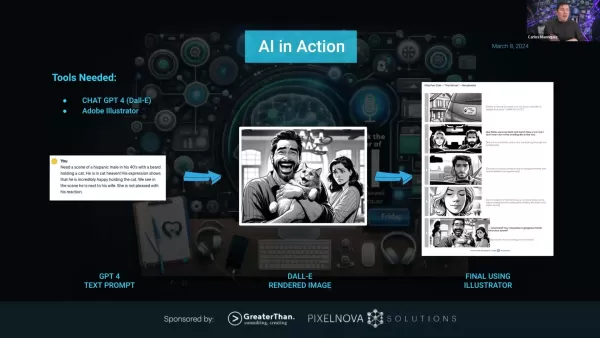
Tips for writing effective prompts:
- Be specific: Clearly describe the scene, characters, and actions. The more detail, the better the AI can capture your vision.
- Use descriptive language: Use evocative words to convey emotions, moods, and visual elements. Adjectives and adverbs add depth and nuance.
- Specify camera angles and framing: Indicate desired camera angles (e.g., close-up, wide shot, overhead) and framing (e.g., medium shot, full shot) to control perspective and composition.
- Iterate and refine: Experiment with different prompts and refine them based on the results. Iteration is key to achieving the desired outcome.
- Incorporate emotional cues: Add cues about the emotions characters should express to guide the AI in generating appropriate facial expressions and body language.
- Consider aspect ratio: Specify the aspect ratio of the image, with '16:9' being ideal for video content. Other formats like square (1:1) are also options.
By crafting your prompts carefully, you can guide AI to generate storyboard frames that accurately reflect your creative vision, saving you significant time and effort.
Generating Images with DALL-E
Once you have your text prompt, you can use DALL-E to generate a corresponding image. DALL-E is an AI model that creates images from text descriptions.
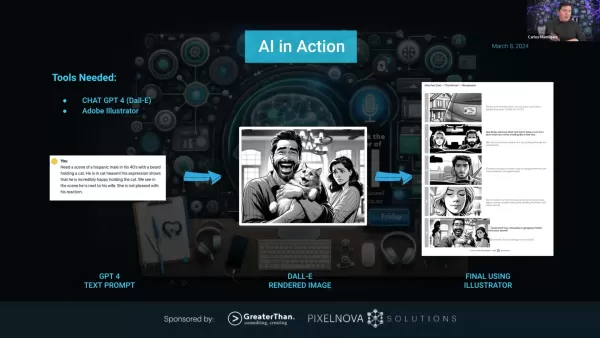
Just input your prompt, and DALL-E will generate a variety of images based on your description. You can then choose the image that best fits your storyboard. If needed, refine the prompt and regenerate images until you achieve the desired result.
DALL-E offers different variations of the images, allowing you to find the best fit. Storyboarding with AI can typically take weeks if outsourced to an artist, but now it can be condensed to half a week.
Refining and Finalizing Storyboard Frames
While AI can generate storyboard frames quickly, refining them is often necessary to achieve the desired look and feel. Adobe Illustrator is a powerful tool for this purpose. With Illustrator, you can:
- Adjust composition: Fine-tune the placement of elements within the frame for a more visually appealing composition.
- Add details: Incorporate specific details that may be missing from the AI-generated image.
- Adjust character expressions: Refine facial expressions and body language to better convey the intended emotions.
- Incorporate brand elements: Add logos, text, or other brand elements to the storyboard.
By combining AI's power with the precision of traditional design tools, you can create storyboards that are both efficient and visually compelling.
Tips for Optimizing AI Outputs
Iterate and Refine
AI-generated content is a great starting point, but it's rarely perfect on the first try. Take the time to iterate and refine the output to ensure it aligns with your specific needs and goals. Edit the text, adjust the formatting, and add your personal touch to create a final version that truly reflects your vision. This iterative approach will help you achieve the best possible results with AI tools.
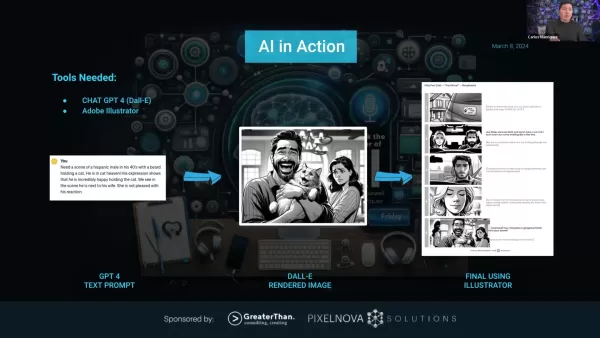
Remember the tools needed for AI production:
- CHAT GPT 4 (Dall-E)
- Adobe Illustrator
FAQ
What are the key benefits of using AI for storyboarding?
AI streamlines storyboarding by quickly generating frames from text prompts, reducing costs and time compared to traditional methods. It also allows for easy iteration and refinement of ideas.
How can GPTs improve my resume and cover letter?
GPTs generate compelling content, tailor it to specific job descriptions, optimize for keywords, and provide inspiration, helping you create high-quality application documents that stand out.
What are some of the best mobile AI apps for productivity?
Top mobile AI apps include Otter.ai for transcription, Krisp for noise reduction, Microsoft Lens for document scanning, Grammarly for grammar checking, and Calendly for scheduling.
Can AI completely replace human artists and writers?
AI can assist with many tasks but is not designed to fully replace humans. Human input is needed for creativity, empathy, and ethical decision-making, and AI can make mistakes like drawing someone with seven fingers.
Related Questions
How can AI tools improve my productivity?
AI tools can automate many tedious tasks, saving you valuable time and effort. For example, AI-powered writing assistants can help you generate content quickly and efficiently, while AI-driven scheduling tools can automate meeting coordination. By delegating these tasks to AI, you can focus on higher-level activities that require your unique skills and expertise.
Related article
 Mariah Carey and Michael Jackson Unite in Stunning AI-Generated Duet
The Future of Music Collaboration: Mariah Carey and Michael Jackson's AI-Generated DuetPicture two legendary voices coming together in perfect harmony - Mariah Carey's breathtaking five-octave range blending seamlessly with Michael Jackson's iconic v
Mariah Carey and Michael Jackson Unite in Stunning AI-Generated Duet
The Future of Music Collaboration: Mariah Carey and Michael Jackson's AI-Generated DuetPicture two legendary voices coming together in perfect harmony - Mariah Carey's breathtaking five-octave range blending seamlessly with Michael Jackson's iconic v
 Dundundance: The Viral Dance Trend Taking Over Social Media
Have you discovered the internet's latest dance obsession that's equal parts hilarious and absolutely addictive? Meet Dundundance - the viral sensation that's not just about steps, but about unleashing pure joy through movement. This global phenomeno
Dundundance: The Viral Dance Trend Taking Over Social Media
Have you discovered the internet's latest dance obsession that's equal parts hilarious and absolutely addictive? Meet Dundundance - the viral sensation that's not just about steps, but about unleashing pure joy through movement. This global phenomeno
 "Exploring AI Safety & Ethics: Insights from Databricks and ElevenLabs Experts"
As generative AI becomes increasingly affordable and widespread, ethical considerations and security measures have taken center stage. ElevenLabs' AI Safety Lead Artemis Seaford and Databricks co-creator Ion Stoica participated in an insightful dia
Comments (6)
0/200
"Exploring AI Safety & Ethics: Insights from Databricks and ElevenLabs Experts"
As generative AI becomes increasingly affordable and widespread, ethical considerations and security measures have taken center stage. ElevenLabs' AI Safety Lead Artemis Seaford and Databricks co-creator Ion Stoica participated in an insightful dia
Comments (6)
0/200
![HenryWalker]() HenryWalker
HenryWalker
 July 27, 2025 at 9:18:39 PM EDT
July 27, 2025 at 9:18:39 PM EDT
AI's ability to create visuals and streamline tasks is mind-blowing! I'm curious how it’ll reshape creative industries in the next decade. 🤯


 0
0
![DanielThomas]() DanielThomas
DanielThomas
 May 22, 2025 at 11:05:49 AM EDT
May 22, 2025 at 11:05:49 AM EDT
스토리보드부터 모바일 앱까지 다양한 걸 도와주는 이 앱은 정말 대단해요! 하지만 인터페이스가 좀 더 직관적이면 좋겠네요. 그래도 전반적으로 매우 유용한 앱이에요 😊


 0
0
![GregoryJones]() GregoryJones
GregoryJones
 May 21, 2025 at 5:32:33 AM EDT
May 21, 2025 at 5:32:33 AM EDT
AIの潜在能力を引き出すアプリは本当に驚きです!ストーリーボードやモバイルアプリの作成に役立ちますが、デザインの一部が少し複雑すぎるように感じます。でも、全体的にはとても便利で、5つ星満点の価値があります。


 0
0
![JimmyJohnson]() JimmyJohnson
JimmyJohnson
 May 20, 2025 at 9:58:23 PM EDT
May 20, 2025 at 9:58:23 PM EDT
Uma ferramenta incrível para quem quer explorar o potencial da IA! Foi muito útil para criar storyboards e até mesmo currículos. No entanto, às vezes fico confuso com alguns recursos mais avançados. Vale a pena testar, com certeza!


 0
0
![AvaHill]() AvaHill
AvaHill
 May 20, 2025 at 7:58:53 PM EDT
May 20, 2025 at 7:58:53 PM EDT
¡Esta app me ha sorprendido mucho! Ayuda a crear cosas geniales como storyboards y apps móviles, pero a veces los pasos son un poco complicados de seguir. A pesar de eso, sigue siendo muy útil 😎


 0
0
![StevenLopez]() StevenLopez
StevenLopez
 May 20, 2025 at 4:09:13 PM EDT
May 20, 2025 at 4:09:13 PM EDT
This app feels like having a personal assistant in your pocket! It’s incredible how it can help with everything from creating storyboards to building mobile apps. The resume builder was particularly helpful. I just wish the interface was a bit more user-friendly. Overall, a solid 4 stars!


 0
0
Artificial intelligence is transforming our daily lives and work environments at a breakneck pace. From generating breathtaking visuals to streamlining mundane tasks, AI tools have become essential for professionals in various fields. This article dives into the practical uses of AI, focusing on three main areas: crafting storyboards, enhancing resumes and cover letters, and exploring top mobile AI apps that can elevate your productivity. Whether you're a filmmaker, job seeker, or just someone looking to harness AI for everyday tasks, this guide will provide you with the insights and tools to tap into AI's potential.
Key Points
- Using ChatGPT and DALL-E to create storyboards for efficient visualization.
- Employing GPTs to craft compelling resumes and cover letters.
- Discovering the best mobile AI apps for various tasks.
- Understanding the advantages and possibilities of AI in creative and professional fields.
- Learning how to refine AI-generated content for the best outcomes.
Storyboard Creation with AI
The Power of AI in Storyboarding
Storyboarding is a vital part of filmmaking, animation, and game development, allowing creators to visualize their concepts and plan scenes before diving into production. Traditionally, this process can be time-consuming, often requiring specialized artists and extensive communication. However, AI offers a game-changing solution that can make storyboarding more efficient.

By using tools like ChatGPT and DALL-E, you can generate storyboard frames from text prompts, significantly cutting down on time and costs compared to traditional methods. This section will guide you on how to effectively use these AI tools to create engaging storyboards.
Key tools for AI-powered storyboarding include:
- ChatGPT 4 (for text prompts)
- DALL-E (for image generation)
- Adobe Illustrator (for final touches, optional)
Crafting Effective Prompts for ChatGPT
The success of AI-generated storyboards hinges on the quality of your text prompts. A well-thought-out prompt can guide ChatGPT and DALL-E to produce images that align closely with your vision.
Here's an example of a prompt for generating a scene in a storyboard:
"You need a scene of a happy male in his 40s with a beard holding a cat. He is in cat heaven! His expression shows that he is incredibly happy holding the cat. We see in the scene he is next to his wife. She is not pleased with his reaction."

Tips for writing effective prompts:
- Be specific: Clearly describe the scene, characters, and actions. The more detail, the better the AI can capture your vision.
- Use descriptive language: Use evocative words to convey emotions, moods, and visual elements. Adjectives and adverbs add depth and nuance.
- Specify camera angles and framing: Indicate desired camera angles (e.g., close-up, wide shot, overhead) and framing (e.g., medium shot, full shot) to control perspective and composition.
- Iterate and refine: Experiment with different prompts and refine them based on the results. Iteration is key to achieving the desired outcome.
- Incorporate emotional cues: Add cues about the emotions characters should express to guide the AI in generating appropriate facial expressions and body language.
- Consider aspect ratio: Specify the aspect ratio of the image, with '16:9' being ideal for video content. Other formats like square (1:1) are also options.
By crafting your prompts carefully, you can guide AI to generate storyboard frames that accurately reflect your creative vision, saving you significant time and effort.
Generating Images with DALL-E
Once you have your text prompt, you can use DALL-E to generate a corresponding image. DALL-E is an AI model that creates images from text descriptions.

Just input your prompt, and DALL-E will generate a variety of images based on your description. You can then choose the image that best fits your storyboard. If needed, refine the prompt and regenerate images until you achieve the desired result.
DALL-E offers different variations of the images, allowing you to find the best fit. Storyboarding with AI can typically take weeks if outsourced to an artist, but now it can be condensed to half a week.
Refining and Finalizing Storyboard Frames
While AI can generate storyboard frames quickly, refining them is often necessary to achieve the desired look and feel. Adobe Illustrator is a powerful tool for this purpose. With Illustrator, you can:
- Adjust composition: Fine-tune the placement of elements within the frame for a more visually appealing composition.
- Add details: Incorporate specific details that may be missing from the AI-generated image.
- Adjust character expressions: Refine facial expressions and body language to better convey the intended emotions.
- Incorporate brand elements: Add logos, text, or other brand elements to the storyboard.
By combining AI's power with the precision of traditional design tools, you can create storyboards that are both efficient and visually compelling.
Tips for Optimizing AI Outputs
Iterate and Refine
AI-generated content is a great starting point, but it's rarely perfect on the first try. Take the time to iterate and refine the output to ensure it aligns with your specific needs and goals. Edit the text, adjust the formatting, and add your personal touch to create a final version that truly reflects your vision. This iterative approach will help you achieve the best possible results with AI tools.

Remember the tools needed for AI production:
- CHAT GPT 4 (Dall-E)
- Adobe Illustrator
FAQ
What are the key benefits of using AI for storyboarding?
AI streamlines storyboarding by quickly generating frames from text prompts, reducing costs and time compared to traditional methods. It also allows for easy iteration and refinement of ideas.
How can GPTs improve my resume and cover letter?
GPTs generate compelling content, tailor it to specific job descriptions, optimize for keywords, and provide inspiration, helping you create high-quality application documents that stand out.
What are some of the best mobile AI apps for productivity?
Top mobile AI apps include Otter.ai for transcription, Krisp for noise reduction, Microsoft Lens for document scanning, Grammarly for grammar checking, and Calendly for scheduling.
Can AI completely replace human artists and writers?
AI can assist with many tasks but is not designed to fully replace humans. Human input is needed for creativity, empathy, and ethical decision-making, and AI can make mistakes like drawing someone with seven fingers.
Related Questions
How can AI tools improve my productivity?
AI tools can automate many tedious tasks, saving you valuable time and effort. For example, AI-powered writing assistants can help you generate content quickly and efficiently, while AI-driven scheduling tools can automate meeting coordination. By delegating these tasks to AI, you can focus on higher-level activities that require your unique skills and expertise.
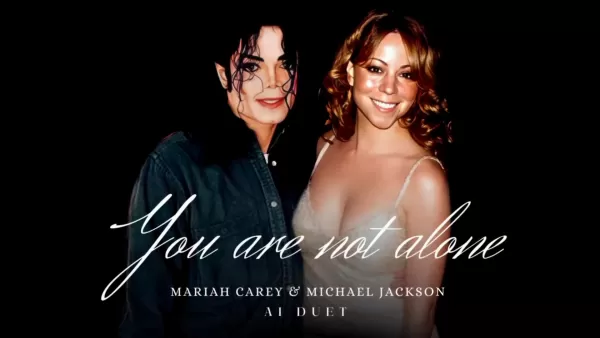 Mariah Carey and Michael Jackson Unite in Stunning AI-Generated Duet
The Future of Music Collaboration: Mariah Carey and Michael Jackson's AI-Generated DuetPicture two legendary voices coming together in perfect harmony - Mariah Carey's breathtaking five-octave range blending seamlessly with Michael Jackson's iconic v
Mariah Carey and Michael Jackson Unite in Stunning AI-Generated Duet
The Future of Music Collaboration: Mariah Carey and Michael Jackson's AI-Generated DuetPicture two legendary voices coming together in perfect harmony - Mariah Carey's breathtaking five-octave range blending seamlessly with Michael Jackson's iconic v
 Dundundance: The Viral Dance Trend Taking Over Social Media
Have you discovered the internet's latest dance obsession that's equal parts hilarious and absolutely addictive? Meet Dundundance - the viral sensation that's not just about steps, but about unleashing pure joy through movement. This global phenomeno
Dundundance: The Viral Dance Trend Taking Over Social Media
Have you discovered the internet's latest dance obsession that's equal parts hilarious and absolutely addictive? Meet Dundundance - the viral sensation that's not just about steps, but about unleashing pure joy through movement. This global phenomeno
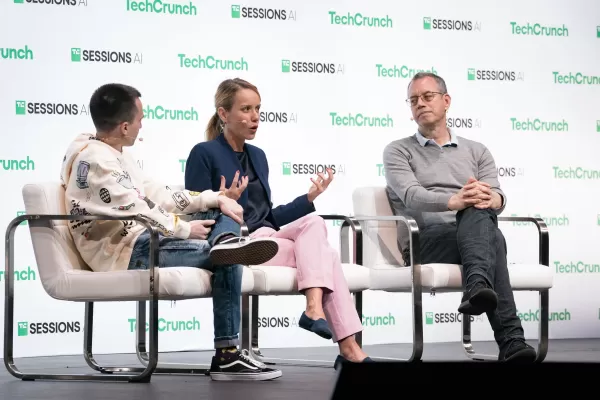 "Exploring AI Safety & Ethics: Insights from Databricks and ElevenLabs Experts"
As generative AI becomes increasingly affordable and widespread, ethical considerations and security measures have taken center stage. ElevenLabs' AI Safety Lead Artemis Seaford and Databricks co-creator Ion Stoica participated in an insightful dia
"Exploring AI Safety & Ethics: Insights from Databricks and ElevenLabs Experts"
As generative AI becomes increasingly affordable and widespread, ethical considerations and security measures have taken center stage. ElevenLabs' AI Safety Lead Artemis Seaford and Databricks co-creator Ion Stoica participated in an insightful dia
 July 27, 2025 at 9:18:39 PM EDT
July 27, 2025 at 9:18:39 PM EDT
AI's ability to create visuals and streamline tasks is mind-blowing! I'm curious how it’ll reshape creative industries in the next decade. 🤯


 0
0
 May 22, 2025 at 11:05:49 AM EDT
May 22, 2025 at 11:05:49 AM EDT
스토리보드부터 모바일 앱까지 다양한 걸 도와주는 이 앱은 정말 대단해요! 하지만 인터페이스가 좀 더 직관적이면 좋겠네요. 그래도 전반적으로 매우 유용한 앱이에요 😊


 0
0
 May 21, 2025 at 5:32:33 AM EDT
May 21, 2025 at 5:32:33 AM EDT
AIの潜在能力を引き出すアプリは本当に驚きです!ストーリーボードやモバイルアプリの作成に役立ちますが、デザインの一部が少し複雑すぎるように感じます。でも、全体的にはとても便利で、5つ星満点の価値があります。


 0
0
 May 20, 2025 at 9:58:23 PM EDT
May 20, 2025 at 9:58:23 PM EDT
Uma ferramenta incrível para quem quer explorar o potencial da IA! Foi muito útil para criar storyboards e até mesmo currículos. No entanto, às vezes fico confuso com alguns recursos mais avançados. Vale a pena testar, com certeza!


 0
0
 May 20, 2025 at 7:58:53 PM EDT
May 20, 2025 at 7:58:53 PM EDT
¡Esta app me ha sorprendido mucho! Ayuda a crear cosas geniales como storyboards y apps móviles, pero a veces los pasos son un poco complicados de seguir. A pesar de eso, sigue siendo muy útil 😎


 0
0
 May 20, 2025 at 4:09:13 PM EDT
May 20, 2025 at 4:09:13 PM EDT
This app feels like having a personal assistant in your pocket! It’s incredible how it can help with everything from creating storyboards to building mobile apps. The resume builder was particularly helpful. I just wish the interface was a bit more user-friendly. Overall, a solid 4 stars!


 0
0





























